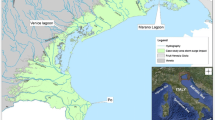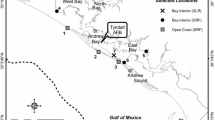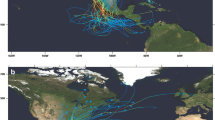Abstract
Planning and design of coastal protection rely on information about the probabilities of very severe storm tides and the possible changes that may occur in the course of climate change. So far, this information is mostly provided in the form of high percentiles obtained from frequency distributions or return values. More detailed information and assessments of events that may cause extreme damages or have extreme consequences at the coast are so far still unavailable. We describe and compare two different approaches that may be used to identify highly unlikely but still physically possible and plausible events from model simulations. Firstly, in the case when consistent wind and tide-surge data are available, different metrics such as the height of the storm surge can be derived directly from the simulated water levels. Secondly, in cases where only atmospheric data are available, the so called effective wind may be used. The latter is the projection of the horizontal wind vector on that direction which is most effective in producing surges at the coast. Comparison of events identified by both methods show that they can identify extreme events but that knowledge of the effective wind alone does not provide sufficient information to identify the highest storm surges. Tracks of the low-pressure systems over the North Sea need to be investigated to find those cases, where the duration of the high wind is too short to induce extreme storm tides. On the other hand, factors such as external surges or variability in mean sea level may enhance surge heights and are not accounted for in estimates based on effective winds only. Results from the analysis of an extended data set suggest that unprecedented storm surges at the German North Sea coast are possible even without taking effects from rising mean sea level into account. The work presented is part of the ongoing project “Extreme North Sea Storm Surges and Their Consequences” (EXTREMENESS) and represents the first step towards an impact assessment for very severe storm surges which will serve as a basis for development of adaptation options and evaluation criteria.










Similar content being viewed by others
References
Casulli V, Cattani E (1994) Stability, accuracy and efficiency of a semi-implicit method for three-dimensional shallow water flow. Computers Math Appl 27(4):99112
DGJ (2014) Deutsches Gewässerkundliches Jahrbuch, Küstengebiet der Nordsee 2013. Landesamt für Landwirtschaft, Umwelt und ländliche Räume Schleswig-Holstein, Flintbek, Germany, http://www.dgj.de, ISSN 2193-6374 (English translation of title: German hydrographical almanac: coastal areas of the North Sea 2013)
Feser F, Barcikowska M, Krueger O, Schenk F, Weisse R, Xia L (2015) Storminess over the North Atlantic and northwestern Europe-A review. QJR Meteorol Soc 141(687):350–382. https://doi.org/10.1002/qj2364
Gaslikova L, Grabemann I, Groll N (2013) Changes in North Sea storm surge conditions for four transient future climate realizations. Nat Hazards 66(3):1501–1518. https://doi.org/10.1007/s11069-012-0279-1
Gerber M, Ganske A, Müller-Navarra S, Rosenhagen G (2016) Categorisation of meteorological conditions for storm tide episodes in the German Bight. Meteorol Z 25(4):447–462. https://doi.org/10.1127/metz/2016/0660
Gönnert G (2003) Sturmfluten und Windstau in der Deutschen Bucht. Charakter, Veränderungen und Maximalwerte im 20. Jahrhundert Die Küste 76:186–365. (English translation of title: Storm tides and surges in the German Bight. Characterisation, changes, and extreme values in the 20th century)
Gönnert G, Sossidi K (2011) A new approach to calculate extreme storm surges: analysing the interaction of storm surge components. WIT Tans Ecol Environ 149:Coastal Processes II. https://doi.org/10.2495/CP110121
Grabemann I, Groll N, Müller J, Weisse R (2015) Climate change impact on North Sea wave conditions: a consistent analysis of ten projections. Ocean Dyn 65(2):255–267. https://doi.org/10.1007/s10236-014-0800-z
Hollweg H, Böhm U, Fast I, Hennemuth B, Keuler K, Keup-Thiel E, Lautenschlager M, Legutke S, Radtke K, Rockel B, Schubert M, Will A, Woldt M, Wunram C (2008) Ensemble simulations over Europe with the regional climate model CLM forced with IPCC AR4 global scenarios. Technical report 3, Support for Climate- and Earth System Research at the Max Planck Institute for Meteorology. ISSN 1619–2257
IPCC (2014) Climate change 2013: the physical science basis. Report, IPCC
IPCC2000 (2000) Special report of the intergovernmental panel on climate change on emission scenarios. Cambridge University Press, United Kingdom. [Summary available online at http://www.ipcc.ch/pub/reports.htm]
IPCC2001 (2001) Climate change 2001: the scientific basis contribution of working group I to the third assessment report of the intergovernmental panel on climate change. Cambridge University Press, United Kingdom and New York
Jensen J, Mudersbach C, Müller-Navarra SH, Bork I, Koziar C, Renner V (2006) Modellgestützte Untersuchungen zu Sturmfluten mit sehr geringen Eintrittswahrscheinlichkeiten an der deutschen Nordseeküste. Die Küste 71:123–167. (English translation of title: Model-based investigations of storm surges with very low probabilities of occurrence at the German North Sea coast)
Kapitza H, Eppel DP (2000) Simulating morphodynamical processes on a parallel system. In: Spaulding ML, Butler HL (eds) Estuarine and coastal modeling. American Society of Civil Engineers, pp 1182–1191
Koziar C, Renner V (2005) Muse: Modellgestützte Untersuchungen zu Sturmfluten mit sehr geringen Eintrittswahrscheinlichkeiten an der Nordseeküste Teilprojekt 1: Numerische Berechnung physikalisch konsistenter Wetterlagen mit Atmosphärenmodellen, Abschlussbericht zum BMBF-Forschungsvorhaben 03KIS039 (KFKI Fördernummer 78). Report, Deutscher Wetterdienst (DWD) Offenbach, (English translation of title: Model-based investigations of storm surges with very low probabilities of occurrence at the German North Sea coast. Sub-project 1: numerical calculation of physically consistent weather patterns with atmospheric models)
Lyard F, Lefevre F, Letellier T, Francis O (2006) Modelling the global ocean tides: modern insights from FES2004. Ocean Dyn 56:394–415. https://doi.org/10.1007/s10236-006-0086-x
Marsland S, Haak H, Jungclaus J, Latif M, Röske F (2003) The Max-Planck-Institute global ocean/sea ice model with orthogonal curvilinear coordinates. Ocean Model 5:91–127. https://doi.org/10.1016/S1463-5003(02)00015-X
Müller-Navarra S H, Giese H (1999) Improvements of an empirical model to forecast wind surge in the German Bight. German J Hydrol 51(4):21. https://doi.org/10.1007/BF02764162
Pätsch J, Burchard H, Dieterich C, Gräwe U, Gröger M, Mathis M, Kapitza H, Bersch M, Moll A, Pohlmann T, Su J, Ho-Hagemann H, Schulz A, Elizalde A, Eden C (2017) An evaluation of the North Sea circulation in global and regional models relevant for ecosystem simulations. Ocean Model 116:70–95. https://doi.org/10.1016/j.ocemod.2017.06.005
Rockel (2008) Special issue regional climate modeling with COSMO-CLM (CCLM), vol 17. Met. Zeitschrift https://doi.org/10.1127/0941-2948/2008/0309
Röckner E, Bäuml G, Bonaventura L, Brokopf R, Esch M, Giorgetta M, Hagemann, Kirchner I, Kornblueh L, Manzini E, Rhodin A, Schlese U, Schulzweida U, Tompkins A (2003) The atmospheric general circulation model ECHAM5. PART I: model description. MPI - Rep. 349, Max Planck Institute for Meteorology
Schmitz H, Habicht D (1988) Barotropic numerical experiments on external surge generation at the edge of the north-western european shelf. Gerlands Beiträge zur Geophysik 97(/5):422–437
Semedo A, Weisse R, Behrens A, Sterl A, Bengtsson L, Günther H (2013) Projection of global wave climate change toward the end of the twenty-first century. J Climate 26(21):8269–8288. https://doi.org/10.1175/JCLI-D-12-00658.1
Weisse R, Plüß A (2005) Storm-related sea level variations along the north sea coast as simulated by a high-resolution model 1958-2002. Ocean Dyn, 10. https://doi.org/10.1007/s10236-005-0037-y
Weisse R, von Storch H, Feser F (2005) Northeast Atlantic and North Sea storminess as simulated by a Regional Climate Model during 1958-2001 and comparison with observations. J Climate 18(3):465–479. https://doi.org/10.1175/JCLI-3281.1
Williams J, Horsburgh K, Williams J, Proctor R (2016) Tide and skew surge independence: new insights for flood risk. Geophys Res Lett 43:6410–6417. https://doi.org/10.1002/2016GL069522
Acknowledgements
Observational data in Borkum were kindly provided by the German Federal Maritime and Hydrographic Agency (BSH) and German Federal Waterways and Shipping Administration (WSV), communicated by the German Federal Institute of Hydrology (BfG).
Funding
This investigation was partly supported in the context of the joint BMBF project EXTREMENESS (Extreme North Sea Storm Surges and Their Consequences) Förderkennzeichen [03F0758].
Author information
Authors and Affiliations
Corresponding author
Additional information
Responsible Editor: Jenny M Brown
This article is part of the Topical Collection on the 15th International Workshop on Wave Hindcasting and Forecasting in Liverpool, UK, September 10-15, 2017
Rights and permissions
About this article
Cite this article
Ganske, A., Fery, N., Gaslikova, L. et al. Identification of extreme storm surges with high-impact potential along the German North Sea coastline. Ocean Dynamics 68, 1371–1382 (2018). https://doi.org/10.1007/s10236-018-1190-4
Received:
Accepted:
Published:
Issue Date:
DOI: https://doi.org/10.1007/s10236-018-1190-4




